Falconidae – Falcons, Kestrels & Caracaras
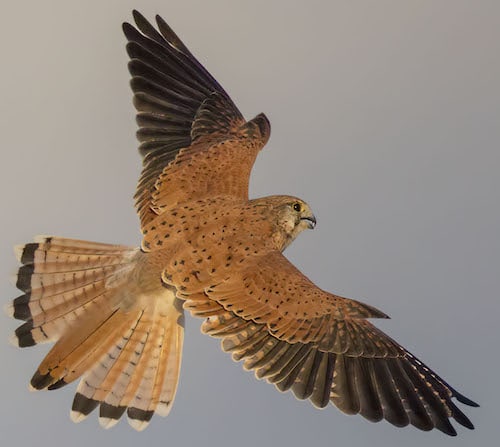
The Falconidae or falcons and caracaras are a family of around 63 species of diurnal birds of prey. The family is divided into two subfamilies, Polyborinae, which includes the caracaras and forest falcons, and Falconinae, the falcons, kestrels and falconets (Microhierax and Spiziapteryx). They differ from the eagles of Accipitridae, in that falcons kill with their beaks instead of their taloned feet. They have a ‘tooth’ on the side of their beak for the purpose.
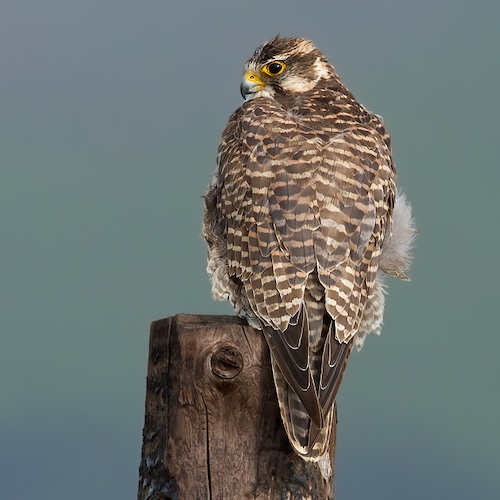
Saker Falcon Falco cherrug
Falcons and caracaras are small to medium-sized birds of prey, ranging in size from the Black-thighed Falconet, which can weigh as little as 35 grams to the Gyrfalcon, which can weigh as much as 1,735 grams. They have strongly hooked bills, sharply curved talons and excellent eyesight. The plumage is usually composed of browns, whites, chestnut, black and grey, often with barring of patterning. There is little difference in the plumage of males and females, although a few species have some sexual dimorphism in boldness of plumage.
 |
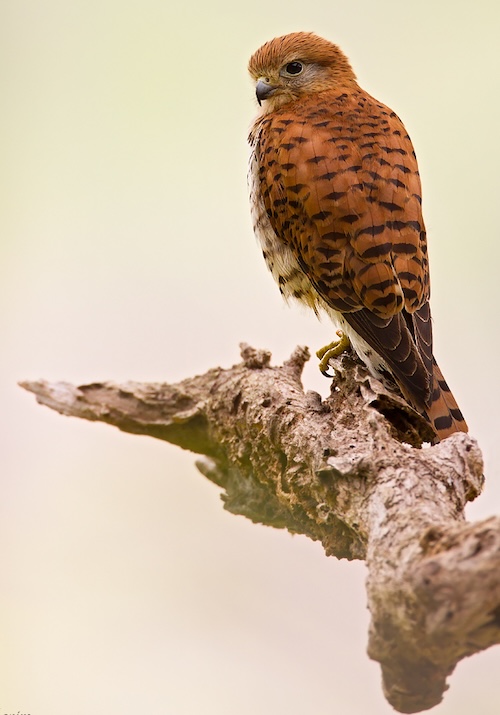 |
| Chimango Caracara Daptrius chimango | Mauritius Kestrel Falco punctatus |
| All Photographs in this text courtesy of ©Dubi Shapiro | |
The family has a cosmopolitan distribution across the world, absent only from the densest forest of central Africa, some remote oceanic islands, the high Arctic and Antarctica. Some species have exceptionally wide ranges, particularly the cosmopolitan Peregrine Falcon, which ranges from Greenland to Fiji and has the widest natural breeding distribution of any bird. Other species have more restricted distributions, particularly island endemics like the Mauritius Kestrel.
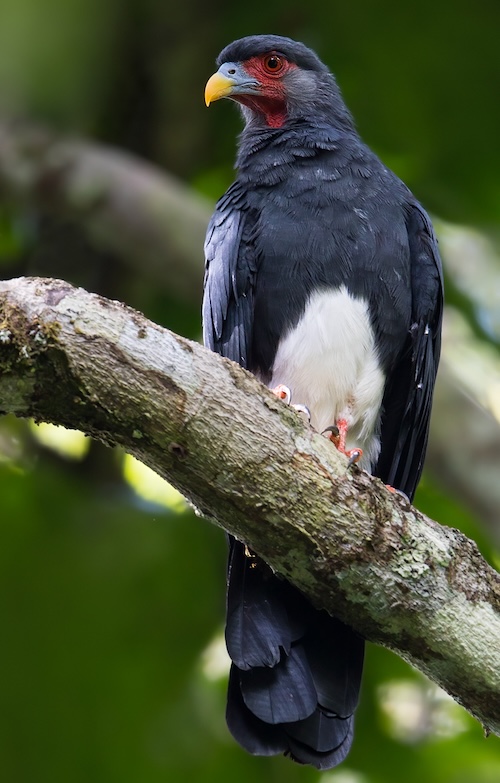 |
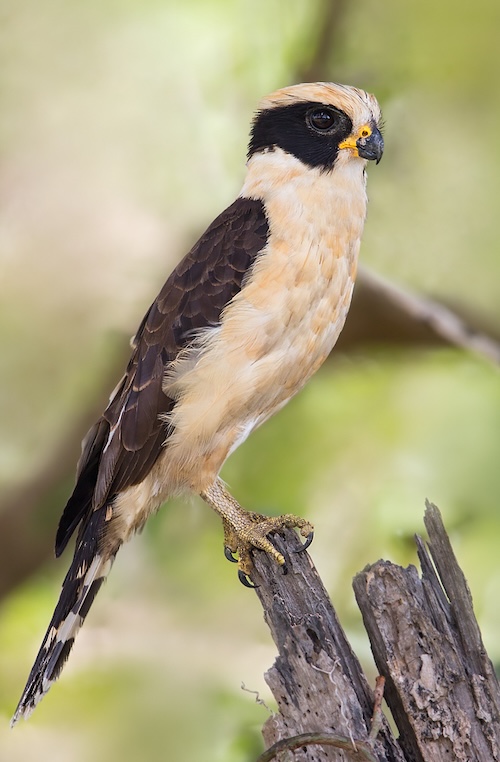 |
| Red-throated Caracara Ibycter americanus | Laughing Falcon Herpetotheres cachinnans |
Most habitat types are occupied, from tundra to rainforest and deserts, although they are generally more birds of open country and even forest species tend to prefer broken forest and forest edges. Some species, mostly in the genus Falco, are fully migratory, with some species summering in Eurasia and wintering entirely in Africa, other species may be partly migratory. The Amur Falcon has one of the longest migrations, moving from East Asia to southern Africa.

Lesser Kestrel Falco naumanni
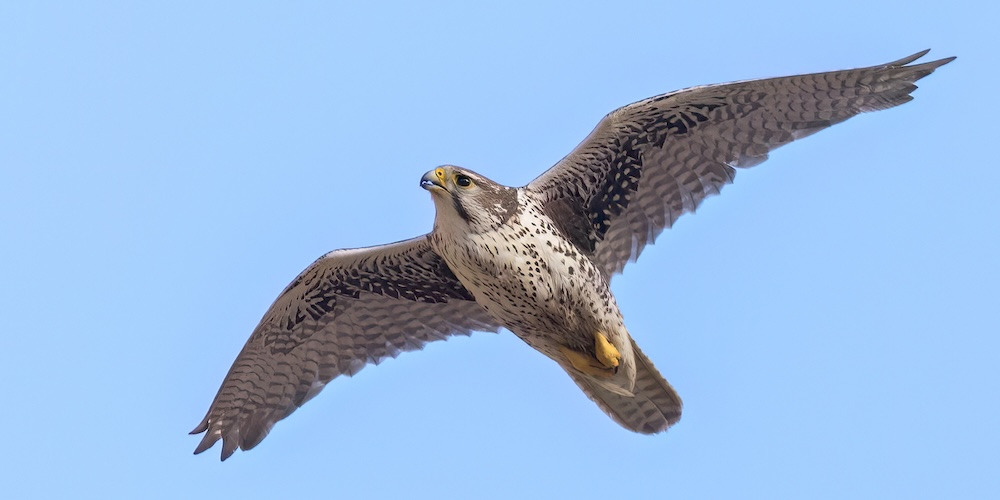
Prairie Falcon Falco mexicanus
Falcons and caracaras are carnivores, feeding on birds, small mammals including bats, reptiles, insects and carrion. In popular imagination the falconids are fast flying predators, and while this is true of the genus Falco and some falconets other species, particularly the caracaras are more sedentary in their feeding. The forest falcons of the Neotropics are generalist forest hunters. Several species, particularly the true falcons, will stash food supplies in caches. They are solitary hunters and pairs guard territories, although they may form large flocks during migration. Some species are specialists, the Laughing Falcon specialises in snakes, others are more generalist.
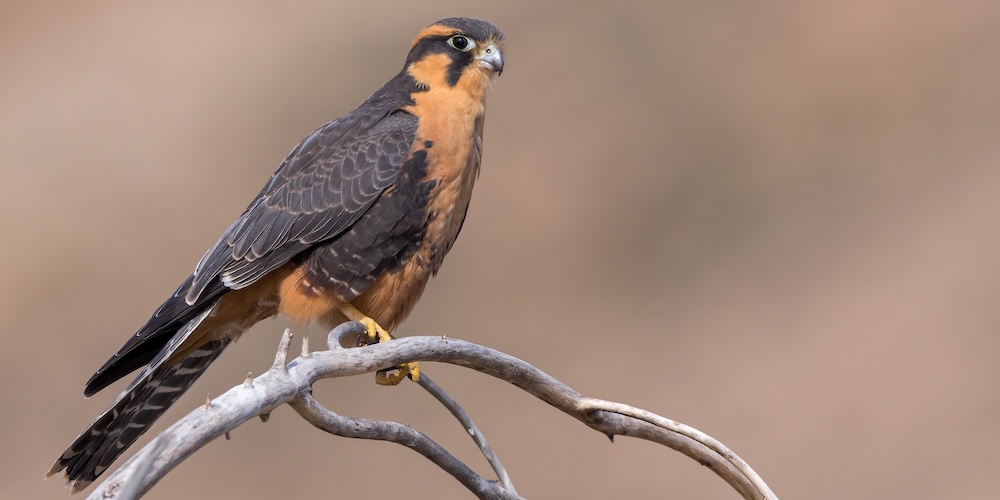
Aplomado Falcon Falco femoralis
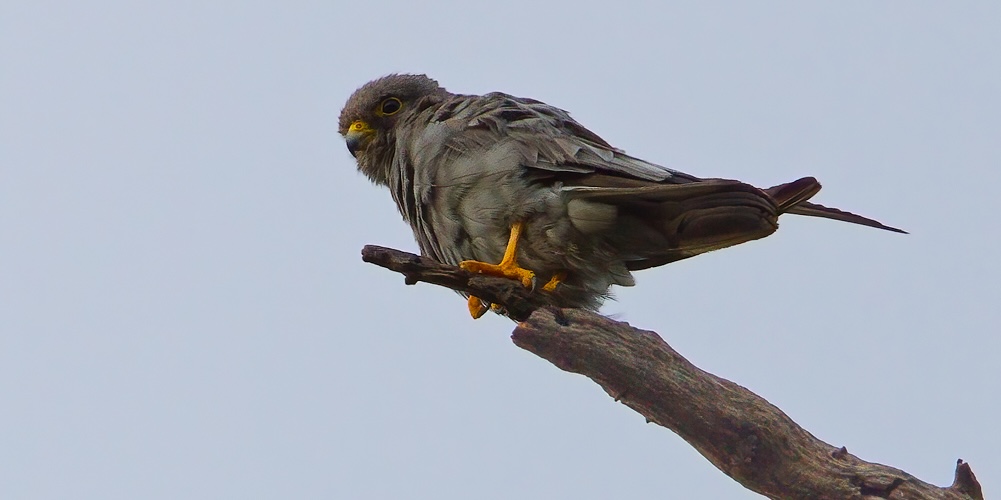
Sooty Falcon Falco concolor
They are generally solitary breeders, although around 10% of species are colonial, for example the Red-footed Falcon. They are monogamous, although some caracaras may also employ alloparenting strategies, where younger birds help adults (usually their parents) in raising the next brood of chicks. Nests are generally not built (except by the caracaras), but are co-opted from other birds, for example Pygmy Falcons nest in the nests of weavers, or on the ledges on cliffs.

Spot-winged Falconet Spiziapteryx circumcincta
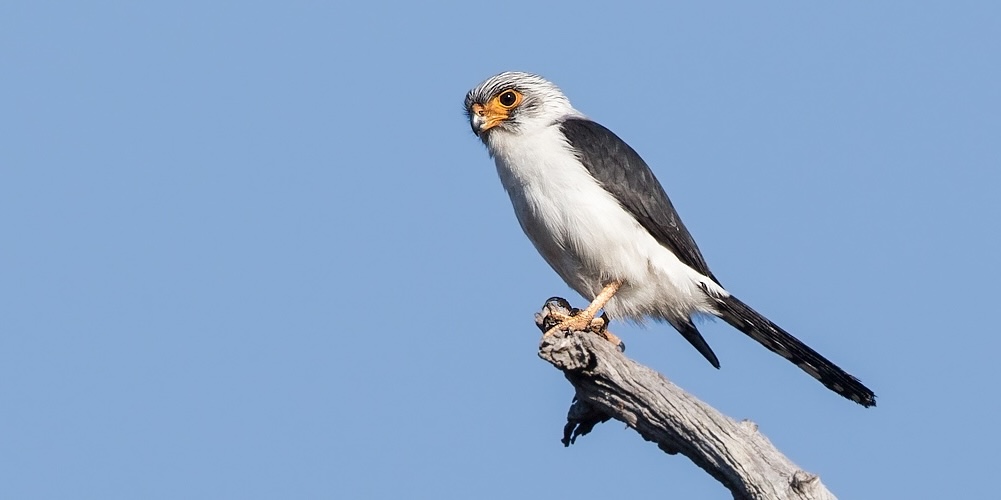
White-rumped Falcon Neohierax insignis
Around 2 to 4 eggs are laid, and mostly incubated by the female. Incubation times vary from species to species and are correlated with body size, lasting 28 days in smaller species and up to 35 days in larger species. Chicks fledge after 28 to 49 days, again varying with size.
-
Number of bird species: 63
(As at September 2025)
According to the recently (2025) amalgamated AviList there are 63 extant species in ten genera in the family Falconidae, which are:
Laughing Falcon Herpetotheres cachinnans
Buckley’s Forest Falcon Micrastur buckleyi
Collared Forest Falcon Micrastur semitorquatus
Slaty-backed Forest Falcon Micrastur mirandollei
Barred Forest Falcon Micrastur ruficollis
Cryptic Forest Falcon Micrastur mintoni
Plumbeous Forest Falcon Micrastur plumbeus
Lined Forest Falcon Micrastur gilvicollis
Spot-winged Falconet Spiziapteryx circumcincta
Southern Crested Caracara Caracara plancus
Red-throated Caracara Ibycter americanus
Yellow-headed Caracara Daptrius chimachima
Black Caracara Daptrius ater
Chimango Caracara Daptrius chimango
Carunculated Caracara Daptrius carunculatus
Mountain Caracara Daptrius megalopterus
White-throated Caracara Daptrius albogularis
Striated Caracara Daptrius australis
Pygmy Falcon Polihierax semitorquatus
Philippine Falconet Microhierax erythrogenys
Pied Falconet Microhierax melanoleucos
Collared Falconet Microhierax caerulescens
Black-thighed Falconet Microhierax fringillarius
White-fronted Falconet Microhierax latifrons
White-rumped Falcon Neohierax insignis
Banded Kestrel Falco zoniventris
Lesser Kestrel Falco naumanni
Fox Kestrel Falco alopex
Greater Kestrel Falco rupicoloides
Mauritius Kestrel Falco punctatus
Seychelles Kestrel Falco araeus
Malagasy Kestrel Falco newtoni
Rock Kestrel Falco rupicolus
Nankeen Kestrel Falco cenchroides
Spotted Kestrel Falco moluccensis
Common Kestrel Falco tinnunculus
American Kestrel Falco sparverius
Red-footed Falcon Falco vespertinus
Amur Falcon Falco amurensis
Merlin Falco columbarius
Grey Kestrel Falco ardosiaceus
Dickinson’s Kestrel Falco dickinsoni
Brown Falcon Falco berigora
Orange-breasted Falcon Falco deiroleucus
Bat Falcon Falco rufigularis
Australian Hobby Falco longipennis
Oriental Hobby Falco severus
Eleonora’s Falcon Falco eleonorae
Sooty Falcon Falco concolor
African Hobby Falco cuvierii
Eurasian Hobby Falco subbuteo
New Zealand Falcon Falco novaeseelandiae
Aplomado Falcon Falco femoralis
Red-necked Falcon Falco chicquera
Prairie Falcon Falco mexicanus
Grey Falcon Falco hypoleucos
Taita Falcon Falco fasciinucha
Peregrine Falcon Falco peregrinus
Lanner Falcon Falco biarmicus
Laggar Falcon Falco jugger
Black Falcon Falco subniger
Gyrfalcon Falco rusticolus
Saker Falcon Falco cherrug
-
BirdLife Australia Raptor Group
WebpagePromoting the study, conservation and management of Australian diurnal and nocturnal birds of prey -
Peregrine Fund
WebsiteThe Peregrine Fund developed from the shared concern of students and associates that the Peregrine Falcon might go extinct in the wild if nothing was done. Our initial work was to learn how to breed falcons in captivity, with the idea the young could be released in the wild to re-establish the Peregrine in the eastern United States where it was already gone and to bolster the greatly diminished western populations -
The Raptor Centre at the University of Minnesota
WebsiteThe Raptor Center is an international medical facility for birds of prey.
-
Bolt from the Blue - Wild Peregrines on the Hunt
| By Dick Dekker | Hancock House | 1999 | Paperback | 192 pages, Col photos, b/w illus | ISBN: 9780888394347 Buy this book from NHBS.com -
Falcons
| By Richard Sale | HarperCollins | 2016 | Paperback | 594 pages, 309 colour photos and colour illustrations, 41 tables | ISBN: 9780007511426 Buy this book from NHBS.com -
Kestrels for Company
| By Gordon Riddle | Whittles Publishing | 2011 | Paperback | 198 pages, 150 col photos, tabs | ISBN: 9781849950299 Buy this book from NHBS.com -
Raptors of the World - A Field Guide
| By James Ferguson-Lees & David Christie | Helm | 2005 | Paperback | 320 pages, 118 colour plates | ISBN: 9780713669572 Buy this book from NHBS.com -
The Common Kestrel
| By Richard Sale | Snowfinch Publishing | 2020 | Hardback | 392 Pages | Colour Photos, Colour Illustrations | ISBN: 9780957173248 | ISBN: 9780957173248 Buy this book from NHBS.com -
The Gyrfalcon
| By Eugene Potapov & Richard Sale | T & AD Poyser Ltd (A & C Black) | 2005 | Hardback | 288 pages, Col photos, illus | ISBN: 9780713665635 Buy this book from NHBS.com -
The Merlin
| By Richard Sale | Snowfinch Publishing | 2020 | Edition 2 | Hardback | 352 Pages | Colour & B&W Photos & Illustrations | ISBN: 9780957173224 Buy this book from NHBS.com -
The Peregrine Falcon
| Richard Sale & Steve Watson | Snowfinch | Edition 2 | 2024 | Paperback | 576 pages, colour & b/w photos, colour & b/w illustrations | ISBN: 9780957173279 Buy this book from NHBS.com
-
Falconidae
Family AccountFalcons specialize on a wide array of animal prey, from grasshoppers and voles to bats and flying birds, whereas caracaras range from generalist predation. -
Falconidae
Family AccountThe falcons and caracaras are around 65 species of diurnal birds of prey that make up the family Falconidae (representing all extant species in the order...
Given the number of species in this family, Fatbirder does not provide quick links to all of them. However, the entries below do include links to representatives of every genera, all those illustrated and some of the most often encountered, iconic or sought-after species.
-
Aplomado Falcon Falco femoralis
Species AccountThe aplomado falcon (Falco femoralis) is a medium-sized falcon of the Americas. The species' largest continuous range is in South America. -
Aplomado Falcon Falco femoralis
Species AccountSound archive and distribution map. -
Black-thighed Falconet Microhierax fringillarius
Species AccountThe black-thighed falconet (Microhierax fringillarius) is one of the smallest birds of prey, typically measuring between 14–16 centimetres (5.5–6.3 in) long, with a 27–32 centimetres (11–13 in) wingspan, which is a size comparable to a typical sparrow.[2] It is native to Brunei Darussalam, Myanmar, Thailand, Malaysia, Singapore and Indonesia. and vagrant to Sri Lanka. -
Black-thighed Falconet Microhierax fringillarius
Species AccountBlack-thighed Falconet Microhierax fringillarius has most recently been assessed for The IUCN Red List of Threatened Species in 2016. Microhierax fringillarius is listed as Least Concern. -
Black-thighed Falconet Microhierax fringillarius
Species AccountSound archive and distribution map. -
Chimango Caracara Daptrius chimango
Species AccountChimango Caracara Daptrius chimango Plumage brownish overall, often with gingery tones, and with variable paler dappling above and fine barring below. -
Chimango Caracara Daptrius chimango
Species AccountSound archive and distribution map. -
Collared Forest Falcon Micrastur semitorquatus
Species AccountThe collared forest falcon (Micrastur semitorquatus) is a species of bird of prey in the family Falconidae. It is the largest member of the Micrastur genus. -
Collared Forest Falcon Micrastur semitorquatus
Species AccountSound archive and distribution map. -
Laughing Falcon Herpetotheres cachinnans
Species AccountSound archive and distribution map. -
Laughing Falcon Herpetotheres cachinnans
Species AccountSpectacular and distinctive raptor of tropical lowlands, often seen perched on prominent bare snags, from which it hunts for snakes. -
Lesser Kestrel Falco naumanni
Species AccountThe lesser kestrel (Falco naumanni) is a small falcon. This species breeds from the Mediterranean across Afghanistan and Central Asia... -
Lesser Kestrel Falco naumanni
Species AccountSound archive and distribution map. -
Mauritius Kestrel Falco punctatus
Species AccountThe Mauritius kestrel (Falco punctatus) is a bird of prey from the family Falconidae endemic to the forests of Mauritius -
Mauritius Kestrel Falco punctatus
Species AccountSound archive and distribution map. -
Nankeen Kestrel Falco cenchroides
Species AccountThe nankeen kestrel (Falco cenchroides), also known as the Australian kestrel, is a raptor native to Australia and New Guinea. -
Nankeen Kestrel Falco cenchroides
Species AccountSound archive and distribution map. -
Peregrine Falcon Falco peregrinus
Species AccountThe peregrine falcon (Falco peregrinus), also known as the peregrine,[1] and historically as the duck hawk in North America,[2] is a widespread bird of prey in the family Falconidae. A large, crow-sized falcon, it has a blue-grey back, barred white underparts, and a black head. As is typical of bird-eating raptors, peregrine falcons are sexually dimorphic, females being considerably larger than males. -
Peregrine Falcon Falco peregrinus
Species AccountPeregrine Falcon Falco peregrinus has most recently been assessed for The IUCN Red List of Threatened Species in 2021. Falco peregrinus is listed as Least Concern. -
Peregrine Falcon Falco peregrinus
Species AccountSound archive and distribution map. -
Prairie Falcon Falco mexicanus
Species AccountLarge, brown-and-white falcon of dry, open areas in western North America. -
Prairie Falcon Falco mexicanus
Species AccountSound archive and distribution map. -
Pygmy Falcon Polihierax semitorquatus
Species AccountSound archive and distribution map. -
Pygmy Falcon Polihierax semitorquatus
Species AccountTiny gray-and-white falcon that is similar in size to a shrike, though chunkier. The back is brown in females and gray in males. -
Red-throated Caracara Ibycter americanus
Species AccountThe red-throated caracara (Ibycter americanus) is a social species of bird of prey in the family Falconidae. -
Red-throated Caracara Ibycter americanus
Species AccountSound archive and distribution map. -
Saker Falcon Falco cherrug
Species AccountThe saker falcon (Falco cherrug) is a large falcon species. It breeds from Central Europe eastwards across the Palearctic to Manchuria. -
Saker Falcon Falco cherrug
Species AccountSound archive and distribution map. -
Sooty Falcon Falco concolor
Species AccountSlim, long-winged, long-tailed falcon that is built for long-distance migration. Adults are all gray, while juveniles have pale, spotted underparts. -
Sooty Falcon Falco concolor
Species AccountSound archive and distribution map. -
Southern Crested Caracara Caracara plancus
Species AccountSound archive and distribution map. -
Southern Crested Caracara Caracara plancus
Species AccountLarge, long-legged raptor of open habitats. Often walks on the ground or perches conspicuously on a fence post or telephone pole. -
Southern Crested Caracara Caracara plancus
Species AccountSouthern Caracara Caracara plancus has most recently been assessed for The IUCN Red List of Threatened Species in 2016. Caracara plancus is listed as Least Concern. -
Southern Crested Caracara Caracara plancus
Species AccountThe southern crested caracara (Caracara plancus), also known as the southern caracara or carancho, is a bird of prey in the family Falconidae. As presently defined, the southern crested caracara is restricted to central and southern South America. -
Spot-winged Falconet Spiziapteryx circumcincta
Species AccountSmall, distinctive falcon of the Chaco from central Argentina to SE Bolivia and W Paraguay, often seen on tall, exposed perches. -
Spot-winged Falconet Spiziapteryx circumcincta
Species AccountSound archive and distribution map. -
White-rumped Falcon Neohierax insignis-rumped Falcon Neohierax insignis
Species AccountThe white-rumped falcon (Neohierax insignis) is a species of bird of prey in the family Falconidae native to Indochina. -
White-rumped Falcon Neohierax insignis-rumped Falcon Neohierax insignis
Species AccountSound archive and distribution map. -
Yellow-headed Caracara Daptrius chimachima
Species AccountAdult is pale buffy with dark brown wings; juvenile is also buffy but with dark streaking all over. -
Yellow-headed Caracara Daptrius chimachima
Species AccountSound archive and distribution map.
-
UK Peregrine Projects
LinksThere are links to many of the UK's Peregrine projects & webcams
-
Aves de Rapina Brasil
WebsiteWelcome to the biggest Brazilian website dedicated to raptors. The webmaster, Willian MenQ, is a graduate student in Biological Sciences. He works in conservation and ornithology in the region the northwest of the Paraná, studying raptors…
